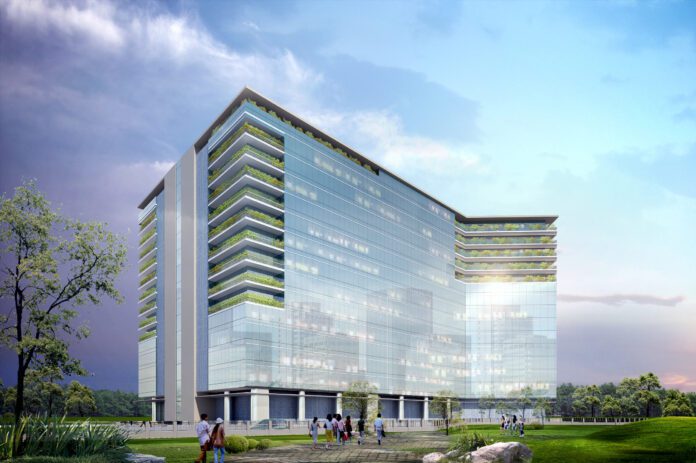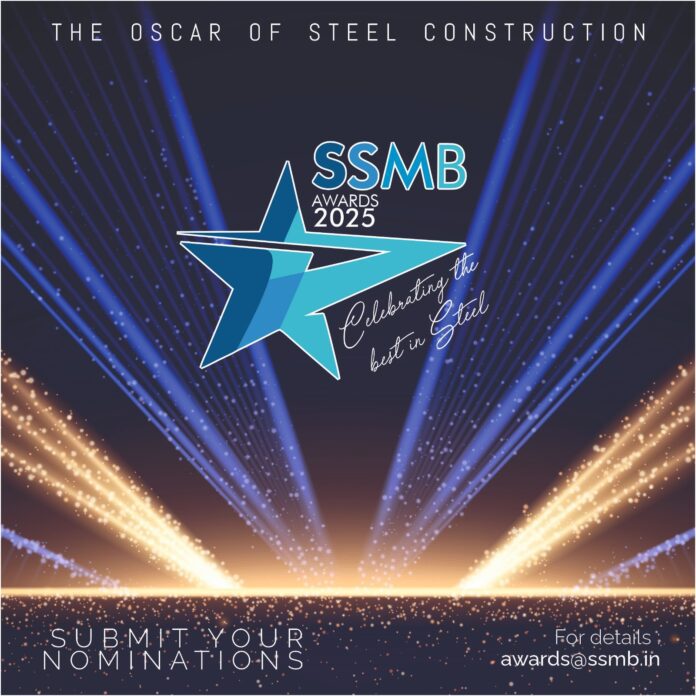Intro: India’s cities are growing taller, faster, and smarter, yet the race for modernity now demands a new kind of intelligence: sustainability. As climate consciousness reshapes the construction industry, steel has re-emerged not only as a structural choice but as a strategic enabler of green innovation. In this evolving landscape, K Raheja Corp, Mindspace Business Parks REIT has consistently demonstrated what it means to build with foresight. With its latest addition, Mindspace Building 12D at Madhapur, Hyderabad, the renewed developer, K Raheja Corp for pioneering integrated developments across the commercial, residential, hospitality, retail, and power sectors has once again raised the benchmark for sustainable commercial design.
This LEED Gold-certified structure is far more than an office building. It is an ecosystem that integrates energy efficiency, environmental responsibility, and human wellness into a single architectural experience. Here, steel, smart technology, and sustainability form the three pillars of a new design ethos: a building that performs, endures, and inspires.
SUSTAINABILITY AS THE BLUEPRINT
The core sustainability vision behind Building 12D stems from a deep commitment to energy efficiency, water conservation, and circular resource use. Designed around LEED Gold Certification parameters, the project demonstrates how every aspect of the built environment can contribute to reducing environmental impact from solar energy harvesting to biodiversity-sensitive landscaping.
Its eco-conscious footprint incorporates rooftop solar systems, intelligent energy management, and water reuse facilities that together enable significant operational savings. The building’s waste management strategy emphasises recycling and composting, while its green landscape design restores native flora and supports pollinators, creating a balanced ecosystem in the middle of a dense urban fabric.
The result is a building that gives back not only in terms of reduced emissions but also through healthier spaces and a measurable improvement in environmental quality. “Sustainability is not a layer we add; it is the core around which the building takes shape,” notes R Arul Prakasam, EVP – Head Engineering & Projects, AP & Telangana, K Raheja Corp.
WHERE PERFORMANCE MEETS POISE
The most successful green buildings are those where performance and aesthetics coexist seamlessly and Mindspace 12D exemplifies this balance, says R Arul Prakasam. The architectural expression of the building is sleek yet rational. Its north-south orientation minimises direct heat gain while maximizing daylight penetration. The façade, a sophisticated combination of high-performance glass and shading devices allows filtered sunlight to flood the interiors, reducing dependence on artificial lighting.
Internally, the design promotes both functionality and wellness. Large, column-free spaces encourage flexibility in interior layouts, while open corridors and terraces enhance natural ventilation. Integrating food courts, breakout zones, and recreational spaces within the building fosters a culture of balance and wellbeing for occupants.
By creating an environment that is both efficient and humane, Building 12D redefines what it means to be a modern, sustainable workplace.
GREEN CERTIFICATION AS A DESIGN DRIVER
Sustainability at Mindspace is not a symbolic gesture, it is a quantifiable pursuit. Having been Hyderabad’s first business park to receive an IGBC Gold Rating, the Mindspace campus set a precedent that every subsequent building, including 12D, has carried forward.
For Building12D, this meant embedding green design at every decision point. The LEED and IGBC guidelines became not just targets, but instruments that shaped the project’s material selection, systems integration, and building envelope performance.
Key sustainable design decisions included:
- Installation of high-performance HVAC systems with heat recovery wheels, improving energy efficiency by up to 30%.
- Use of LED lighting and motion sensors to reduce electricity consumption during off-peak hours.
- Selection of locally available, recycled materials, reducing the carbon footprint of logistics and raw material sourcing.
- Deployment of an advanced Building Management System (BMS) for real-time energy monitoring and optimization.
- Implementation of rainwater harvesting systems, low-flow fixtures, and advanced STPs, ensuring responsible water use and near-zero discharge.
By integrating technology with ecological thinking, the project moves beyond compliance, as it achieves true performance-based sustainability.
INTELLIGENCE IN ORIENTATION
The subtropical climate of Hyderabad informed the very geometry of Building 12D. Passive design principles were woven into the concept from the outset, shaping the building’s orientation, façade design, and material palette.
The north-south alignment strategically minimises exposure to harsh solar angles while welcoming the softer daylight from the east and west. Overhangs and vertical fins act as passive regulators, deflecting high-angle summer sun while permitting low winter sunlight.
The external glazing, optimised for both visible light transmission and thermal insulation, maintains comfortable indoor temperatures year-round. Operable windows and ventilated corridors channel prevailing winds across the workspace, reducing the cooling load on HVAC systems.
The result is a building that breathes naturally, a microclimate that offers comfort without energy excess.
“Passive design here is not a concession, it is an act of intelligence.”
– R Arul Prakasam
SUSTAINABILITY THROUGH STEEL
If sustainability is the soul of the project, steel is its skeleton.
The use of steel in Building 12D reflects not only structural efficiency but also a philosophy of circular construction. During redevelopment, steel recovered from the demolition of earlier structures within the campus was salvaged, sorted, and recycled into the new framework. This act of material continuity turned demolition waste into valuable input, drastically reducing landfill generation and raw material dependency.
Moreover, using recycled steel cut down carbon emissions significantly when compared to producing fresh steel from iron ore. The inherent durability, resilience, and flexibility of steel ensures longevity, reducing the frequency of renovations or structural interventions.
Prefabricated components, precision-engineered off-site, allowed for faster erection and reduced material wastage. The steel system also provides large column-free spans, creating adaptable interior spaces that can evolve with changing tenant requirements — an essential feature in long-term sustainable design.
“Steel is not just a material, it is a mindset that supports speed, sustainability, and scalability.”
CIRCULAR DESIGN AND EMBODIED CARBON REDUCTION
Sustainability doesn’t end at operational efficiency; it begins at embodied carbon reduction. The project’s structural strategy combined smart material optimisation, modular construction, and reuse of existing resources to lower emissions even before occupancy.
Through life-cycle assessment (LCA) tools, the design team tracked the embodied carbon footprint of major materials, prioritising low-impact options and recycled content. Compared to conventional concrete-heavy commercial buildings, building 12D records a 20–25 per cent lower embodied carbon value, making it one of Hyderabad’s most climate-conscious commercial developments.
This approach aligns closely with ESG (Environmental, Social, Governance) principles, demonstrating that the path to sustainability begins long before a building is operational.
INTEGRATION WITH GREEN CONTEXT
One of the standout features of Building 12D is its biophilic relationship with its surroundings. The building doesn’t isolate itself from nature, it integrates with it. The façade transparency creates a visual dialogue between the interiors and the lush outdoor landscape. Strategic openings frame views of gardens, courtyards, and skywalks, turning nature into an active participant in the workspace experience.
Physically, the project enhances its green context through tree-lined walkways, outdoor seating pods, and green buffers that moderate the site’s microclimate. The extension of existing skywalks promotes pedestrian movement across the Mindspace campus, further strengthening its human and ecological connectivity.
These interventions collectively lower heat island effects, improve air quality, and foster an emotional connection between occupants and their environment.
SMART BUILDING MANAGEMENT, REAL-TIME EFFICIENCY
In the digital age, sustainability must go beyond design, it must evolve continuously. Building 12D exemplifies this through its intelligent Building Management System (BMS), which integrates IoT sensors to track energy, water, and air quality data in real time.
The BMS dynamically optimises HVAC performance, lighting intensity, and occupancy schedules. This data-driven adaptability ensures that energy waste is virtually eliminated while maintaining ideal thermal comfort. Predictive maintenance alerts further extend equipment lifespan and reduce downtime, proving that smart infrastructure is the new frontier of sustainable operation.
THE HUMAN SIDE OF GREEN DESIGN
Beyond its technical systems, building 12D recognises that true sustainability is as much about people as it is about performance. Workspaces are bathed in natural daylight, landscaped terraces offer spaces for informal interaction, and the air quality is actively maintained through smart filtration.
These biophilic and wellness-oriented features directly contribute to employee satisfaction, productivity, and mental health, reinforcing the global understanding that sustainable design is also good business design.
“Sustainable workplaces don’t just consume less, they produce more: more creativity, more comfort, more value.”
A BENCHMARK FOR INDIA’S GREEN FUTURE
In the context of India’s Tier-1 cities, Mindspace Building 12D emerges as a benchmark for scalable sustainability. Its success lies in demonstrating that commercial viability and environmental responsibility can go hand in hand.
From steel’s recyclability to intelligent automation, from passive design to biodiversity integration, every facet of the project reflects a unified design ethos: build with purpose, operate with precision, and evolve with integrity.
WHY GOING GREEN MATTERS
The shift toward sustainable construction is not just ecological — it’s strategic.
Green buildings offer measurable advantages:
- Lower operational costs, with up to 30% energy savings annually.
- Enhanced asset value, attracting ESG-focused investors and multinational tenants.
- Improved occupant well-being, thanks to healthier indoor environments.
- Future regulatory resilience, as India moves toward stricter carbon codes.
By investing in green-certified structures, developers are not just contributing to climate goals, they are future-proofing their assets and redefining what long-term profitability looks like.
GREEN HIGHLIGHTS
Project: Building 12D, Mindspace, Hyderabad
Certification: LEED Gold
Developer: K Raheja Corp, Mindspace Business Parks REIT
Structural System: Steel + RCC Composite
Key Sustainability Metrics:
- 25% reduction in overall energy consumption
- 20–25% lower embodied carbon
- 100% on-site wastewater recycling
- Use of recycled steel and local materials
- 30% faster construction through prefabrication
- Intelligent BMS for real-time resource management
- Passive design delivering 15–18% lower cooling load
Editorial Note:
Mindspace Building 12D embodies the essence of modern sustainability, a seamless synthesis of structural intelligence, environmental consciousness, and human experience. Its success is not defined merely by certification but by conviction, a belief that progress and preservation can, and must, coexist. As India continues its journey toward greener cities, projects like these offer a blueprint for how the construction industry can evolve: through innovation, collaboration, and an unrelenting commitment to balance.




